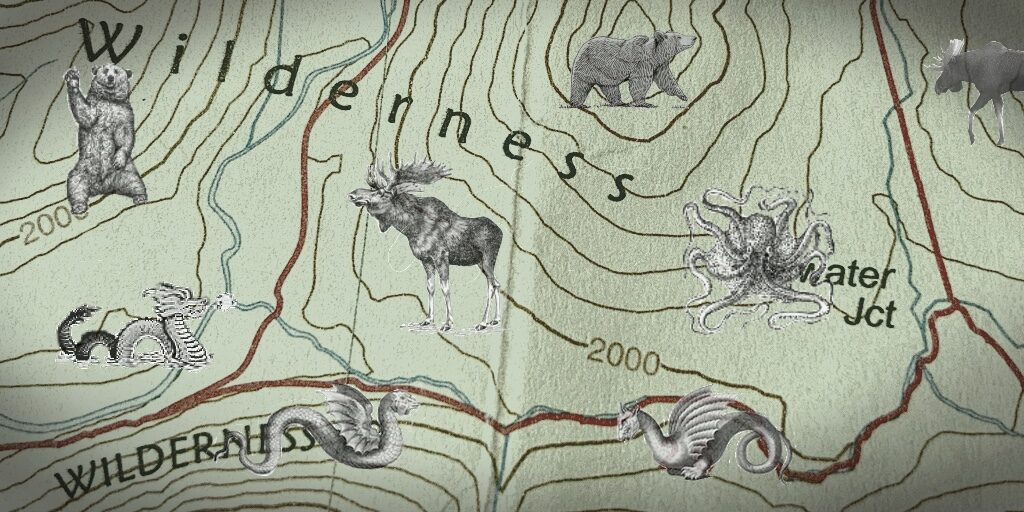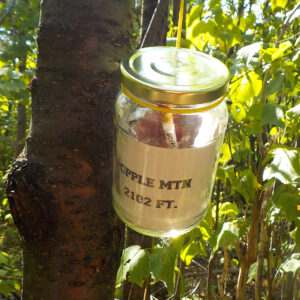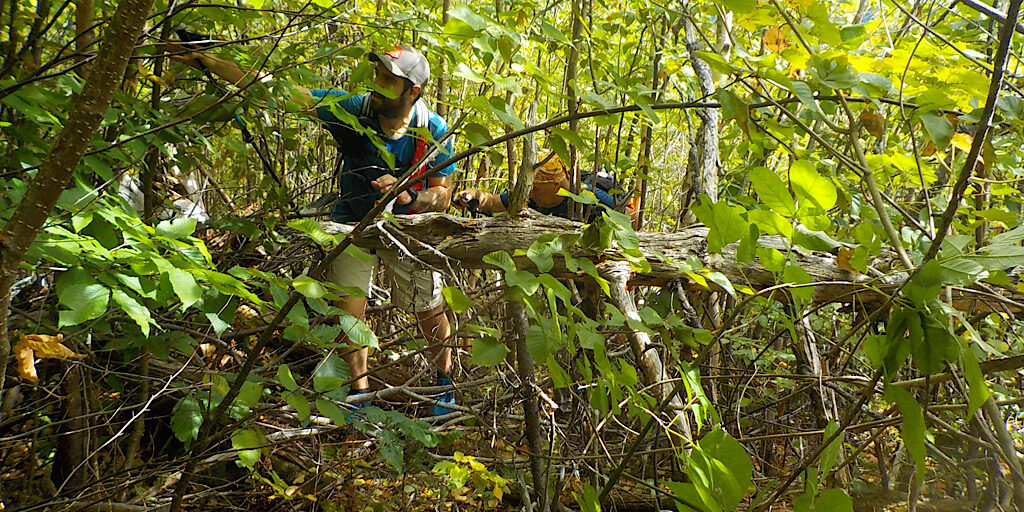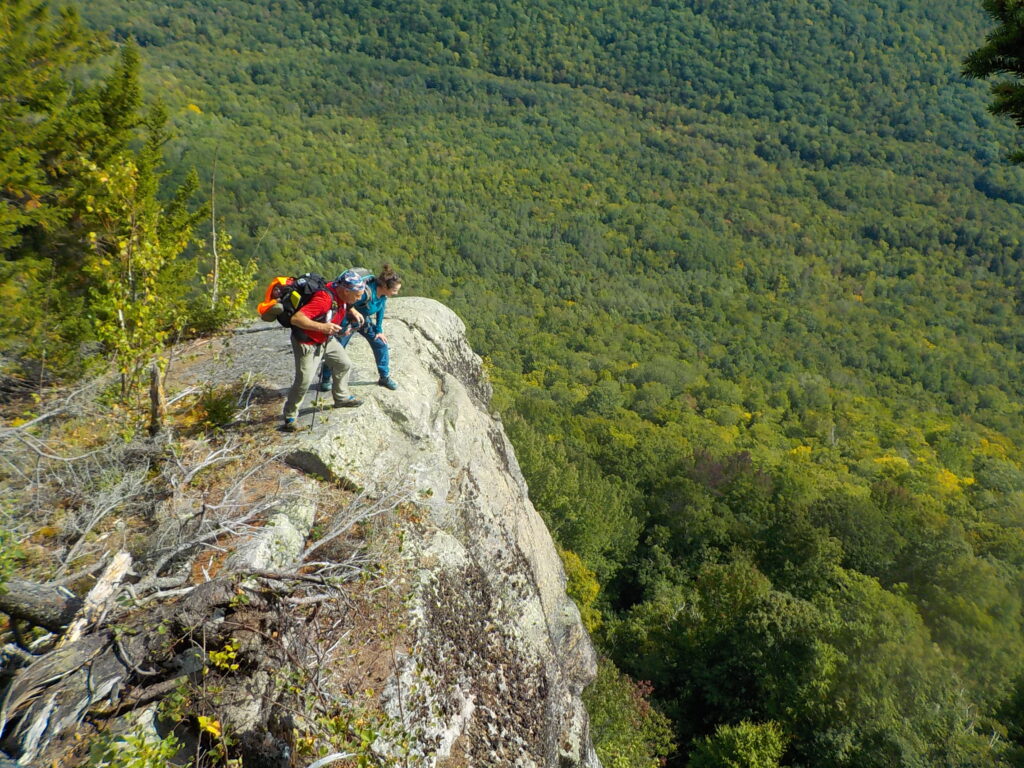
Beware stranger for there be unfathomable horrors lurking in the unknown.
bush·whack (verb)
/ˈbo͝oSHˌ(h)wak/
1. live or travel in wild or uncultivated country.
 This isn’t going to be a promotion. We wouldn’t do that to our friends. We’re not trying to sell you on anything. What we will be talking about doing in this article would in fact be dangerous and a bit foolish for most people. So, don’t do it. To be clear, this isn’t a recommendation. Nor is it a suggestion. Rather, we will present an observation. And that observation is this: there’s nothing left. Or to be more precise, what’s left seems to be shrinking. In 2020 we have observed more people on established trails. Popular trails are tramped like never before — though we have observed the vast majority of hikers are being considerate and practicing good trail etiquette. However, parking and litter has been an issue, as reported and as seen first hand. The lesser used trails have become suddenly very popular. And the rest of them, once just the fodder of the dedicated hardcore red-liner, or lost person, have also become a curious agenda item for the general quarantined-to-death (“caution fatigued”) public.
This isn’t going to be a promotion. We wouldn’t do that to our friends. We’re not trying to sell you on anything. What we will be talking about doing in this article would in fact be dangerous and a bit foolish for most people. So, don’t do it. To be clear, this isn’t a recommendation. Nor is it a suggestion. Rather, we will present an observation. And that observation is this: there’s nothing left. Or to be more precise, what’s left seems to be shrinking. In 2020 we have observed more people on established trails. Popular trails are tramped like never before — though we have observed the vast majority of hikers are being considerate and practicing good trail etiquette. However, parking and litter has been an issue, as reported and as seen first hand. The lesser used trails have become suddenly very popular. And the rest of them, once just the fodder of the dedicated hardcore red-liner, or lost person, have also become a curious agenda item for the general quarantined-to-death (“caution fatigued”) public.

Most trailless peaks have some sort of marking.

Bushwhacker signing a register.
 Nowadays there are lists for everything we can think of. It is pretty well assured every hill in New Hampshire has been visited by a number of people simply there to “bag” it. Understandably this is a very limited group of people. Bushwhacking is not for everyone. In fact, it’s not for hardly anyone. It’s usually not that much fun. What is fun is the personal exploration, the exercise perhaps, and the company of friends if one is so lucky as to actually have friends who ‘shwhack. It is a rare breed. Being hung up in the pencil-woods, sweating, trying to stay on your feet in steep terrain, blackflies getting in your eyes, mosquitoes buzzing in your ears… it just isn’t that much to look forward to. It is what it is, however, and that’s what’s left. That is New Hampshire’s final frontier. Ours and yours.
Nowadays there are lists for everything we can think of. It is pretty well assured every hill in New Hampshire has been visited by a number of people simply there to “bag” it. Understandably this is a very limited group of people. Bushwhacking is not for everyone. In fact, it’s not for hardly anyone. It’s usually not that much fun. What is fun is the personal exploration, the exercise perhaps, and the company of friends if one is so lucky as to actually have friends who ‘shwhack. It is a rare breed. Being hung up in the pencil-woods, sweating, trying to stay on your feet in steep terrain, blackflies getting in your eyes, mosquitoes buzzing in your ears… it just isn’t that much to look forward to. It is what it is, however, and that’s what’s left. That is New Hampshire’s final frontier. Ours and yours.

Exploring the final frontier is sometimes incredibly challenging.
Important Things to Consider Before You Go
If you have decided to ignore our advice and want to start your own exploration, going there for yourself, please…
-
- Tread lightly
- Be careful what you step on for your own safety as well as for the environment.
- Don’t make trails
- Expanding on that above, leave your machete at home. Bushwhacking in NH is not literal.
- Don’t mark passages
- Expanding even further on that above, also leave the flagging tape at home. Let nature stay natural.
- Practice LNT
- This will be redundant to many of these rules, but Leave No Trace bears repeating in our opinion.
- Don’t go alone
- Bushwhack with a friend for safety reasons. Many things can happen out there so having backup is a must.
- Be independent
- To further define this dependency, your team must be able to stand on its own. There is no help out there.
- Leave a detailed plan
- Your best bet if something goes awry is that you told someone the specific details of your plan and you stuck to it.
- Plan the trip well
- Be thorough in your planning and consider “Plan B” scenarios. (Then convey this all to your at-home backup.)
- Manage time correctly
- Quite simply, do you have adequate day-length to carry out your plan, while leaving extra time for the unexpected?
- Use available resources
- From knowledge base materials like Internet-based trip reports, to technology like satellite imagery, use what exists.
- Know map and compass
- Don’t bushwhack without a solid understanding of plotting and following a compass course, and triangulation. Know the tools.
- Learn to use apps/GPS
- Know and use the tools above, but then add to your navigation arsenal with technological aids… because you can.
- Don’t get specific
- While sharing on social media is a fun thing to do, try not to give away specific details about your route. Make people plan.

Some of the rewards, however, are hard to beat.
